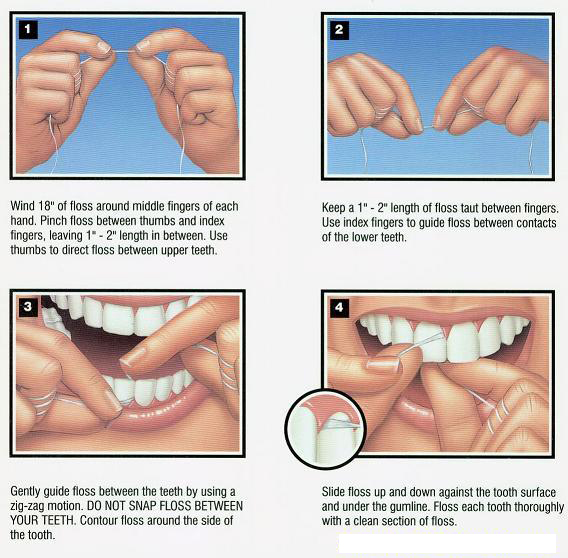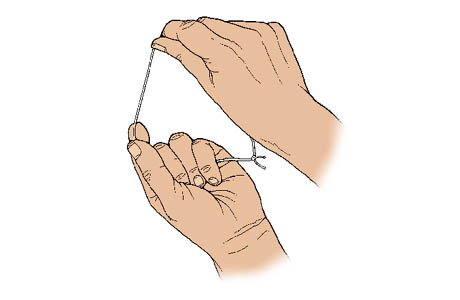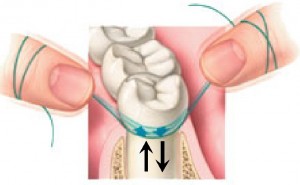The American Dental Association advises that flossing your teeth thoroughly be done once or more per day. Overly vigorous or incorrect teeth flossing can result in damage to the gum tissues therefore this article will provide some basics on flossing.
What is flossing?
Dental floss is made of either a bundle of thin nylon filaments or a plastic that is indicated for plaque and debris removal in areas where teeth contact with each other. The floss is gently inserted between the teeth and scraped along the teeth sides, especially close to the gums. An alternative tool to achieve the same effect is the interdental brush, which is more helpful in areas where the gums have receded in between the teeth
Methods of flossing
The two frequently used dental flossing methods are the spool method and the circle, or loop, method. Control of the floss and ease of handling can be seen in both methods. Flossing of teeth is a complex skill, so until children develop adequate dexterity (which is usually around the age of 10 to 12 years), an adult should perform flossing on the child. Younger children whose teeth still exhibit primate spaces (where there is no contact between adjacent teeth) will not require flossing.
The spool method
The spool method is particularly suited for teenagers and adults who have acquired the necessary coordination required to use floss. When using the spool method, a piece of floss approximately 18 inches long is used. The bulk of the floss is lightly wound around the middle finger. Space should be left between wraps to avoid impairing circulation to the fingers. The rest of the floss is similarly wound around the same finger of the opposite hand. This finger can wind, or “take up,” the floss as it becomes soiled or frayed to permit access to an unused portion. The last three fingers are clenched and the hands are moved apart, pulling the floss taut, thus leaving the thumb and index finger of each hand free. The floss is then secured with the index finger and thumb of each hand by grasping a section three quarters to 1 inch long between the hands.
The loop method
The loop method is suited for children as well as adults with less nimble hands or physical limitations caused by conditions such as poor muscular coordination or arthritis. For the loop method, the ends of the 18-inch piece of floss are tied in a knot. All of the fingers, but not the thumbs of the two hands are placed close to one another within the loop. Whether using the spool or the loop method of flossing, the same basic procedures are followed. The thumb and index finger of each hand are used in various combinations to guide the floss between the teeth.
When inserting, floss, it is gently eased between the teeth with a seesaw motion at the contact point. The gentle seesaw motion flattens the floss, making it possible to ease through the contact point and prevent snapping it through, thus avoiding trauma to the gums in between the teeth. Once past the contact point between teeth, the floss is adapted to each approximating surface by creating a C-shape. The floss is then directed downwards towards the gumline and back to the contact area (up-and-down against the side of the tooth) several times or until the tooth surface is clean. The procedure is repeated on the adjacent tooth in the proximal area, using care to prevent damage to the gums in between while readapting to the adjacent tooth. A clean, unused portion should be used for each area between teeth.
In general, tooth flossing is best performed by cleaning each tooth in succession, including the back surface of the last tooth in each quadrant. Incorrect flossing can often be detected through observation of the gums and the technique. Signs that suggest incorrect use of dental floss include cuts on the gums, bleeding gums, indentation on the soft tissues of the mouth, and wear on tooth root surfaces near the gumline. If flossing trauma is evident, further instruction should be given until the individual has become adept. Proper instruction and practice allows most motivated adults to master either the spool or loop method of flossing. In certain circumstances, the use of a floss holder, floss threader, variable-thickness floss, or pre-cut floss strands with a stiff end may be more effective.
It is important to note that a flossing habit has traditionally been difficult for people to embrace. In reality, only a very small proportion of individuals practice daily flossing. Floss may be superior to other interproximal (the area between teeth) cleaning methods, but for those who have not or will not adopt a flossing behavior another interproximal device may be more effective than no interproximal cleaning. A less effective device used on a regular basis is superior to irregular use of a more effective device.



